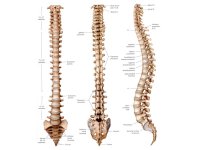The issue is about evolution.
Some have a very naive notion that evolution is about constant change.
When the clear facts show it is not true.
There is change of some things and preservation of other things.
And the things that change rapidly like height or skin color are meaningless. Humans can survive and reproduce at any height or with any skin color.
While the things that resist change like the hand or other functional systems are significant. Change these and the likelihood of reproduction usually declines.
There is no resistance...
No resistance to change in the skeletal structure of the hand?
You simply won't believe your eyes because the picture is in conflict with your preconceptions and misunderstandings of evolution.
Gould is right about the resistance to change within species. And the fossil record backs him up. We don't see gradual change in the human skeletal structure. We do see punctuated changes to the skull which reflect changes to the brain which seem to occur but they occur instantaneously in terms of the fossil record. We see no intermediaries.
And possibly it took the last great leap into the modern human brain to have the capacity for the language system. Which is the core of the cognitive system. Which integrated with what was probably already an elaborate system of animal communication (not language).
The sentience of reproductive success. That which grants success must remain for the success to remain.
The sentience of sexual selection. Those visible or auditory or possibly tactile traits most appealing will have a greater likelihood of sexual success and therefore likely reproductive success.
Oh no! Say it isn't so!!!
The inherent means of reproductive success. You act as if reproductive success is nothing. As if it is meaningless. It isn't everything but it is something.
just mutation that leaves things as they are or changes things
No. There are other things that can happen. There is replication of the same genes. This of course can lead to segmentation.

And segmentation is what makes us possible. Mutation is necessary in combination with the initial replications.
If tool making leads to good consequences mutations related to aspects of tool making that increase that advantage are preferred
Evidence disproves this.
As human culture developed humans became better and better at tool making but the hand did not change at all.
What made human culture possible was language. Humans had a hand a long time before they had culture. Most likely meaning language arose very recently (within 50,000 to 100,00 years ago) and it arose very quickly.
Mutation is the result of chance and physics which tends to a norm, thus continuous mutation hypothesis.
That's not in dispute.
Most of the mutations do nothing. Those that do something most likely do something negative.
The very rare mutations that actually do something positive MIGHT get passed on and spread to offspring. They might not.
Geniuses do not pass their genius to their offspring.
All these factors about mutations create a stability within the genome.
Disasters happen randomly opening up niches through which mutations or unfavorably positioned competing genes may become the most fit.
Yes, it with the occasional catastrophic events that great changes take place.
This is part of the theory of Punctuated Equilibrium.
But in general species resist change. The fossil record is clear on this.
The hand is one of those things that have demonstrably changed with the advent of tool making. Thus the punctuated hypothesis.
The relation of the hand to tool making is pure speculation.
And there are still questions when the modern human structure arrived.
Earliest modern human-like hand bone from a new >1.84-million-year-old site at Olduvai in Tanzania
The discovery of OH 86 suggests that a hominin with a more MHL postcranium co-existed with Paranthropus boisei and Homo habilis at Olduvai during Bed I times.
http://www.nature.com/articles/ncomms8987


